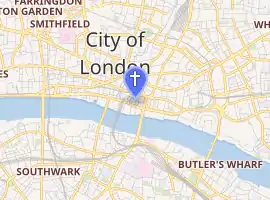St Laurence Pountney
St Laurence Pountney was a Church of England parish church in the Candlewick Ward of the City of London. It was destroyed in the Great Fire of 1666, and not rebuilt.
| St Laurence Pountney | |
|---|---|
 Current photo of site | |

| |
| Location | Laurence Pountney Hill London |
| Country | United Kingdom |
| Denomination | Anglican |
| History | |
| Founded | 13th century |
| Architecture | |
| Demolished | 1666 |
History
The church stood on the west side of what is now Laurence Pountney Lane, between Cannon Street and Upper Thames Street in the Candlewick ward of the city.
The earliest known mention of the church comes in a charter, ostensibly written in the reign of William I, but in fact a mid-12th century forgery. It records the king's confirmation of a previous grant of St Laurence's to Westminster Abbey. During the late 13th and early 14th centuries the church was recorded under various names including "St Laurence next the Thames" , "St Laurence in Candlewigstrate" and "Sancti Laurenc’ de Lundenestane". The later name "Pountney" comes from the mayor Sir John de Pultneye, who founded and endowed the Chapel of Corpus Christi and St John the Baptist adjoining the north side of the church as a college for a master and seven chaplains.[1] The college is known to have been in existence by 1332. Part of its endowment consisted of the patronage of the church itself, which Pultneye had obtained from Westminster Abbey.[2] It was suppressed during the reign of Edward VI.[3]
The church had a tower with a tall wooden spire, covered in lead. [3] A programme of improvements was undertaken at the cost of the parish in 1631–2, in the course of which the spire was releaded, a set of five new bells was hung in a new frame, and the floors were raised and levelled.[4] There was a churchyard to the south, with a substantial retaining wall.[1]
Destruction
St Laurence's was destroyed in the Great Fire of London of 1666. An eye-witness told the Government inquiry into the fire that he "saw the Fire break out from the inside of Lawrence Pountney Steeple, when there was no fire near it", implying the possibility of arson.[5] The church was not rebuilt. Instead the parish was united to that of St Mary Abchurch.[1] The old churchyard, which lay to the south side of the church continued to be used for burials; in the 1850s it was converted into the garden of a neighbouring house, then occupied by the architect Edward I'Anson. This 17th century building, which still exists, is now numbered as 7a Laurence Pountney Hill.[1] The site of the church itself, which became known as the "Church Ground", was used as an additional burial ground following the Great Fire, and is now also a privately owned garden.[6]
References
- Holder, Nick; Phillpotts, Christopher (2011). "A 17th-Century City Merchant's House at 7A Laurence Pountney Hill and its Medieval Predecessor". Transactions of the London and Middlesex Archaeological Society. 61: 131–47.
- "A History of the County of London: Volume 1, London Within the Bars, Westminster and Southwark" (Originally published by Victoria County History, London, 1909).
- Newcourt 1708, p. 389.
- Seymour 1733, p. 474.
- Jenkinson 1917, p. 164.
- "St Laurence Pountney Graveyards". London Parks and Gardens Trust. Retrieved 8 May 2012.
Sources
- Jenkinson, Wilberforce (1917). London Churches Before the Great Fire. London: Society for the Promotion of Christian Knowledge.
- Newcourt, Richard (1708). Repetorium Ecclesiasticum Parochiale Londinense. 1. London.
- Seymour, Robert (1733). A Survey of the Cities of London and Westminster, Borough of Southwark, and Parts Adjacent. 1. London: T. Read.
Further reading
- Wilson, H.B. (1831). History of the parish of St. Laurence Pountney, London : including, from documents hitherto unpublished, an account of Corpus Christi (or Pountney) College, in the said parish. London: C. Rivington & Co.
- Wright, G.W. (1904). St. Mary Abchurch and St. Laurence Pountney: a short account. London: A. Fullarton & Co.
- "Sir John de Pulteney and his two residences in London, Cold Harbour and the manor of the rose, together with a few remarks on the parish of St. Lawrence Poultney". Archaeologia. 57 part 2: 257–84. 1901. doi:10.1017/s0261340900014132.